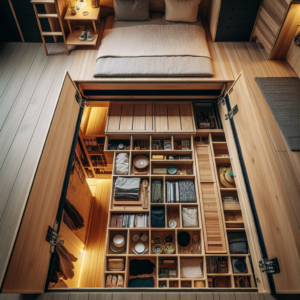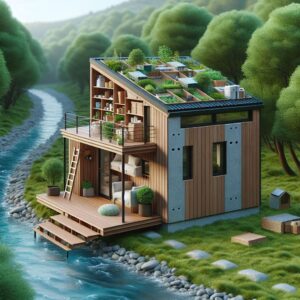Key Takeaways
-
Vertical gardens are space-efficient and can turn tiny house lofts into vibrant, green spaces.
-
Choosing the right plants and containers is crucial for a successful tiny house garden.
-
DIY projects can add a personalized touch to your vertical garden while saving space.
-
Effective water management is essential to keep your tiny house clean and your plants thriving.
-
Rotating plants and ensuring they get enough light and air will maintain plant health.
Maximizing Your Space with Vertical Garden Storage
Tiny house living requires ingenuity, especially when it comes to gardening. The key to green thumbs in small spaces? Go vertical! Vertical gardens are not just a trend; they are a practical solution for growing your favorite plants without sacrificing precious floor space. In this guide, I’ll walk you through the ins and outs of creating a lush vertical garden in the loft of your tiny house. We’ll explore everything from selecting the right plants to DIY storage tips that are both functional and stylish. Let’s transform your tiny house into a green sanctuary!

Why Vertical Gardens are Perfect for Tiny Houses
The beauty of vertical gardens lies in their versatility and space efficiency. When you’re living in a tiny house, every inch counts. Vertical gardens take advantage of the often-underused vertical space, allowing you to grow herbs, flowers, and even some vegetables. They also add a layer of insulation, improve air quality, and, most importantly, bring a sense of nature and tranquility into your home. Besides that, they’re a creative way to express your personality and style through the living art of plants.
Getting Started with Your Vertical Garden
Starting a vertical garden in your tiny house loft is easier than you might think. First, assess the light conditions. Most plants need plenty of light, so if your loft doesn’t get enough natural sunlight, consider installing grow lights. Next, think about the weight. Your vertical garden needs to be structurally sound, so choose lightweight materials and containers. Finally, decide on the type of vertical garden system that works best for you, whether it’s hanging planters, wall-mounted pockets, or freestanding shelves.
Finding Room for Greenery in Unlikely Places
Your tiny house loft is an ideal spot for a vertical garden, but don’t stop there. Look for other spaces that could benefit from a touch of greenery. The side of a cabinet, the end of a counter, or even a sunny window can become a mini garden with the right setup. The goal is to integrate plants into your living space in a way that is both beautiful and practical.
Transforming Lofts Into Lush Retreats
Lofts are often used for storage or sleeping, but with a bit of creativity, they can also become your personal oasis. Start by choosing plants that thrive in the specific conditions of your loft. For instance, if your loft gets a lot of light, succulents and cacti are great choices. If it’s on the shadier side, go for ferns or ivy. Use a mix of trailing and upright plants to create visual interest and depth.
Utilizing Wall Space for Hanging Planters
Wall space is prime real estate for vertical gardens. Hanging planters are a simple and effective way to add greenery without taking up floor space. You can use a variety of containers, from traditional pots to repurposed items like mason jars or tin cans. Just make sure they have proper drainage to prevent water damage to your walls.
One of my clients transformed their loft wall into a stunning herb garden using a series of hanging planters. They now have fresh basil, mint, and rosemary at their fingertips, and the aroma adds a delightful touch to their tiny home.
Choosing the Right Plants for Your Space
Selecting the right plants for your vertical garden is crucial. You want to look for species that not only suit the light, temperature, and humidity of your tiny house loft but also won’t outgrow their space. Dwarf varieties and slow growers are your best bet. For example, consider herbs like thyme and oregano, which stay compact and are useful in the kitchen. Leafy greens like lettuce and spinach are also great for vertical gardens because they have shallow roots and thrive in containers.
Essential Tools for Plant Care in Small Spaces
To keep your vertical garden healthy, you’ll need a few tools tailored for small spaces. A watering can with a long spout provides precision and reach, making it easier to water plants without spilling. Compact pruners or scissors are a must for trimming and harvesting. If you’re using a soil-based system, a small hand trowel or fork will be necessary for planting and repotting. And don’t forget a spray bottle for misting plants that prefer higher humidity!
Stylish and Functional Vertical Storage Solutions
Your vertical garden should be as much about aesthetics as it is about function. Think of your plant storage as a piece of living art. Sleek shelving or a chic ladder planter can serve as a focal point in your tiny house. When selecting storage solutions, consider materials that complement your interior design. Wood adds warmth, metal provides an industrial edge, and clear acrylic shelves can make your plants appear as if they’re floating.
Remember, the goal is to create a harmonious space where your garden and living area flow together seamlessly. Use your vertical garden to enhance your home’s ambiance, not overwhelm it. With a thoughtful approach, you can achieve a balance that feels both lush and organized.
Incorporating Shelves and Racks into Your Garden Design
Shelves and racks are the backbone of any vertical garden. They can be as simple as repurposed bookshelves or as elaborate as custom-built units. When incorporating these into your tiny house loft, consider adjustable shelving that allows you to change the configuration as your plants grow. For a streamlined look, use uniform pots or baskets. If you prefer a more eclectic style, mix and match containers for a unique display.
Creative DIY Projects for Personalized Storage
DIY enthusiasts can take vertical garden storage to the next level by creating their own solutions. Pallet gardens are a popular choice – they’re affordable and can be customized to fit any space. Another idea is to upcycle old picture frames into living wall art by adding a backing, soil, and succulents. These projects not only save space but also add a personal touch to your tiny house, making your garden truly one of a kind.
Overcoming Challenges with Tiny House Vertical Gardens
While vertical gardens are a great solution for tiny house living, they do come with their own set of challenges. Watering, for instance, can lead to excess moisture and mess if not managed properly. And because space is limited, it’s important to ensure that each plant receives adequate light and airflow to prevent disease and promote growth.
Managing Water and Mess in a Small Area
Water management is key in a tiny house garden. To minimize mess, use containers with drainage holes and place them on trays to catch any runoff. Consider a drip irrigation system for a more automated approach, which can be especially helpful if you’re often on the move. It’s also a good idea to water your plants in the morning, giving them time to absorb moisture and dry out during the day, reducing the risk of mold and mildew in your small space.
Ensuring Adequate Light and Airflow for Plant Health
Plants need light to thrive, so it’s essential to position your vertical garden in a spot where it will receive plenty of it. If natural light is limited, grow lights can provide the necessary spectrum for photosynthesis. Airflow is another critical factor; good circulation prevents pests and diseases. Use a small fan to keep the air moving or simply open a window to let in a fresh breeze, ensuring your plants stay healthy and happy.
Frequently Asked Questions
How to Water a Vertical Garden Without Making a Mess?
Watering a vertical garden in a tiny house can be tricky, but it’s all about the right tools and techniques. Use a watering can with a long spout to target the roots directly and avoid spillage. For higher planters, consider a small step ladder to ensure you can reach without straining. Drip trays are a must—they catch excess water and protect your home. If you’re tech-savvy, a drip irrigation system is a fantastic investment, delivering water directly to each plant and saving you time.
What Are the Best Plants for High-Humidity Areas Like Lofts?
In high-humidity areas like lofts, you’ll want plants that naturally thrive in moist environments. Ferns, mosses, and air plants are all excellent choices because they can absorb moisture from the air. Orchids and peace lilies also do well in humid conditions and add a touch of elegance. Always check the specific needs of each plant, as some may require more ventilation to prevent rot and fungal diseases.
Are Vertical Gardens Expensive to Install?
The cost of installing a vertical garden varies greatly depending on the complexity and size of the project. Simple DIY options can be quite affordable, especially if you repurpose materials. For example, a pallet garden can be made for the price of soil and plants if you have a spare pallet lying around. More advanced setups with irrigation systems and grow lights will increase the cost but offer convenience and efficiency. Overall, vertical gardens can be tailored to fit any budget.
How Often Should I Rotate Plants in a Vertical Garden?
Rotating your plants ensures that they grow evenly and receive equal exposure to light and airflow. The frequency of rotation depends on the growth rate and type of plants you have. As a general rule, a monthly check and rotation is a good practice. If you notice that one side of your plant is turning towards the light or growing unevenly, it’s a sign that it’s time to rotate.
Can I Incorporate Edible Plants in My Tiny House Vertical Garden?
Absolutely! Edible plants like herbs, strawberries, and leafy greens are perfect for vertical gardens. They are not only practical and delicious but also bring a delightful burst of life to your tiny house. Just be sure to choose varieties that are suited for container growing and consider their sunlight and watering needs. With a bit of planning, you can have a bountiful, space-saving edible garden right in your loft.





